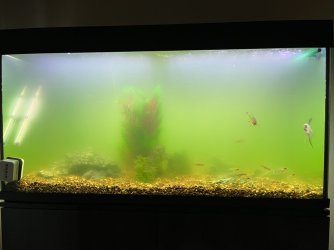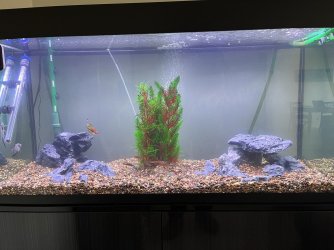Guggle
New Member
Hi everyone,
We have a 280 litre tropical tank with Tetras, Danios, Anglefish, a Red Torpedo, zero real plants, and several rocks of varying size (whose type escapes me, but I know they produce lime).
Several weeks ago we had a bad algae bloom (see before and after photos). We tried many different things to resolve it - mass water changes, high doses of API Algaefix, no water changes, leaving the light off for a week, adding a carbon filter to the biological filter - without success. We were advised by a local retailer to stop using Sera Bio Nitrivec (something we added religiously during water changes for many years). We were also advised by another local retailer to use a Pond One UV Stabiliser which finally did the trick. It took about 4 days for the green cloud to turn into a white cloud which was subsequently removed over the following week or two with water changes.
We lost no fish during the bloom or the treatment phase, and things seem to have settled down now, so we have some questions for the community:
Michael.
We have a 280 litre tropical tank with Tetras, Danios, Anglefish, a Red Torpedo, zero real plants, and several rocks of varying size (whose type escapes me, but I know they produce lime).
Several weeks ago we had a bad algae bloom (see before and after photos). We tried many different things to resolve it - mass water changes, high doses of API Algaefix, no water changes, leaving the light off for a week, adding a carbon filter to the biological filter - without success. We were advised by a local retailer to stop using Sera Bio Nitrivec (something we added religiously during water changes for many years). We were also advised by another local retailer to use a Pond One UV Stabiliser which finally did the trick. It took about 4 days for the green cloud to turn into a white cloud which was subsequently removed over the following week or two with water changes.
We lost no fish during the bloom or the treatment phase, and things seem to have settled down now, so we have some questions for the community:
- What things do we need to do post bloom to ensure it doesn’t happen again?
- Should we start to add the Nitrivec at water changes again, or is it optional?
- We still have some surface algae (on the rocks, glass, etc). Is this cause for concern?
- Although it's hard to see in the 'after' photo, there is still a mild milkiness to the water. Again, is this cause for concern?
Michael.



